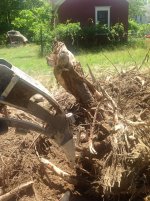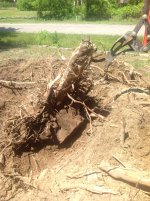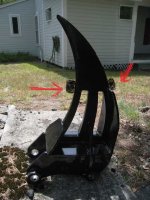Interesting! I found that my ripper would have been more effective if I cut down the chipper tooth width at the bottom and I still want to add a scoop to the back, but it's going to take a while because I have other money making projects going on.
You are using an out of date browser. It may not display this or other websites correctly.
You should upgrade or use an alternative browser.
You should upgrade or use an alternative browser.
john deere 260 backhoe ripper
- Thread starter swick1
- Start date
/ john deere 260 backhoe ripper
#41
Six month update: it still works fine but I could have made it about half as heavy duty. I really need to put a plate on the back because it will dig in around big roots and make the tractor do a wheelie. A sawzall with a Long pruning blade works just as well. If I had it to do over again I'd spend the money on a power inverter for the truck to run the sawzall
IslandTractor
Super Star Member
- Joined
- Sep 15, 2005
- Messages
- 17,101
- Location
- Prudence Island, RI
- Tractor
- 2007 Kioti DK40se HST, Woods BH
I was using my ripper today. The back plate really does help prevent the ripper from pulling the tractor down into a hole and also is useful to scrape out spoils at about two shovel fulls each load.
I don't have any serrated edge on my ripper but I do have two welded pieces of drill pipe that act as "meat hooks" and tear out a chunk of root whenever they pass over it with pressure. The hook on the backside of the blade is most useful for tearing up thick lateral roots that I cannot break directly with the ripper blade. I isolate the root and then put the back side of the ripper against it then move the dipper forwards and backwards with down pressure. The hook takes out about half an inch to an inch of the root each pass until it is sufficiently weakened that I can then just rip through it using the standard ripping technique. Worked well today on a big Maple stump. Photos show the stump upside down still in the hole (I was digging the dirt out of the ball) and shows the bit lateral root sticking straight up. Too big to simply break with the ripper so the hooks made the difference.
I don't have any serrated edge on my ripper but I do have two welded pieces of drill pipe that act as "meat hooks" and tear out a chunk of root whenever they pass over it with pressure. The hook on the backside of the blade is most useful for tearing up thick lateral roots that I cannot break directly with the ripper blade. I isolate the root and then put the back side of the ripper against it then move the dipper forwards and backwards with down pressure. The hook takes out about half an inch to an inch of the root each pass until it is sufficiently weakened that I can then just rip through it using the standard ripping technique. Worked well today on a big Maple stump. Photos show the stump upside down still in the hole (I was digging the dirt out of the ball) and shows the bit lateral root sticking straight up. Too big to simply break with the ripper so the hooks made the difference.
Attachments
Coyote machine
Super Member
- Joined
- May 4, 2009
- Messages
- 7,660
- Location
- Southern VT
- Tractor
- 22 SANY SY 50U, '10 Kioti DK 40se/hst KL-401 FEL, loaded tires, KB-2485 bhoe, Tuffline TB160 BB, Woods QA forks, MIE Hydraulic bhoe thumb & ripper tooth, Igland 4001 winch, & GR-20 Log Grapple. Woods BBX72" Brush Mower. Diamondplate aluminum canopy
I was using my ripper today. The back plate really does help prevent the ripper from pulling the tractor down into a hole and also is useful to scrape out spoils at about two shovel fulls each load.
I don't have any serrated edge on my ripper but I do have two welded pieces of drill pipe that act as "meat hooks" and tear out a chunk of root whenever they pass over it with pressure. The hook on the backside of the blade is most useful for tearing up thick lateral roots that I cannot break directly with the ripper blade. I isolate the root and then put the back side of the ripper against it then move the dipper forwards and backwards with down pressure. The hook takes out about half an inch to an inch of the root each pass until it is sufficiently weakened that I can then just rip through it using the standard ripping technique. Worked well today on a big Maple stump. Photos show the stump upside down still in the hole (I was digging the dirt out of the ball) and shows the bit lateral root sticking straight up. Too big to simply break with the ripper so the hooks made the difference.
Nice job!
What's up with the boat covered in the back of the pic?
Last edited:
Coyote machine
Super Member
- Joined
- May 4, 2009
- Messages
- 7,660
- Location
- Southern VT
- Tractor
- 22 SANY SY 50U, '10 Kioti DK 40se/hst KL-401 FEL, loaded tires, KB-2485 bhoe, Tuffline TB160 BB, Woods QA forks, MIE Hydraulic bhoe thumb & ripper tooth, Igland 4001 winch, & GR-20 Log Grapple. Woods BBX72" Brush Mower. Diamondplate aluminum canopy
FWIW,
The following link will take you to pics of the second gen of the tooth, of which I have the identical item, (the first one, made to my specs, with the cooperation of Bob from MIE), for my Kioti DK-40; what I call the CLAW!
http://www.tractorbynet.com/forums/2748399-post299.html
See the pics in the post below the initial text.
Note: I haven't had time to use it too much since purchase, BUT it has done everything I've told it to with no complaints. It excels at trenching, shoveling small amounts of dug-out dirt/rocks etc., and I'm certain it will kick some at ripping roots, which is why I had the teeth added, to make it rip with a vengeance, and little effort on the user's part. MIE can and will make a CLAW for any tractor's hoe given the specs requested on the form in the link shown above.
The following link will take you to pics of the second gen of the tooth, of which I have the identical item, (the first one, made to my specs, with the cooperation of Bob from MIE), for my Kioti DK-40; what I call the CLAW!
http://www.tractorbynet.com/forums/2748399-post299.html
See the pics in the post below the initial text.
Note: I haven't had time to use it too much since purchase, BUT it has done everything I've told it to with no complaints. It excels at trenching, shoveling small amounts of dug-out dirt/rocks etc., and I'm certain it will kick some at ripping roots, which is why I had the teeth added, to make it rip with a vengeance, and little effort on the user's part. MIE can and will make a CLAW for any tractor's hoe given the specs requested on the form in the link shown above.
J_J
Super Star Member
- Joined
- Sep 6, 2003
- Messages
- 18,928
- Location
- JACKSONVILLE, FL
- Tractor
- Power-Trac 1445, KUBOTA B-9200HST
IslandTractor,
I would recommend that you cut back the weld rod so that the steel looks like a tooth, both ends, point to the outside and indent to the weld part, maybe a 30 degree taper.
Coyote machine,
I would recommend a saw type tooth cut into the ripper, instead of the pyramid cut, maybe with a small piece of carbide brazed on to the face tooth.
I would recommend that you cut back the weld rod so that the steel looks like a tooth, both ends, point to the outside and indent to the weld part, maybe a 30 degree taper.
Coyote machine,
I would recommend a saw type tooth cut into the ripper, instead of the pyramid cut, maybe with a small piece of carbide brazed on to the face tooth.
IslandTractor
Super Star Member
- Joined
- Sep 15, 2005
- Messages
- 17,101
- Location
- Prudence Island, RI
- Tractor
- 2007 Kioti DK40se HST, Woods BH
IslandTractor,
I would recommend that you cut back the weld rod so that the steel looks like a tooth, both ends, point to the outside and indent to the weld part, maybe a 30 degree taper.
.
I understand JJ. The current set up was purely a matter of expedience as I had the drill tube segments and wanted to figure out if they would help. I guessed at position and just used the bandsaw cut drill pipe as is given the sharp 360 degree edge. Having them undercut a bit would help snag the root but my current method, just using some downforce with the dipper, seems to work too. It is drill bit hardened steel so I am not sure I want to spend hours with a grinder trying to shape it further. I may give it a try and maybe settle for a very shallow angle just to minimize grinding. Maybe cutting a V shaped notch in the front and rear face would help.
I should also note that while the position of the drill pipe "tooth" on the back of the blade seems about right, I wish I had welded the one on the front side a little closer to the tip. I originally just wanted something to catch flexible roots that were "riding up" the ripper as it curled but realize now it would be more useful, without interfering with the main blade, if it were mounted another 4-6 inches towards the tip. That way it would function like the one on the back and actually be taking a chunk out of big roots as I curl. It is a bit too far back now to have much impact there on big roots like the one in the photos above.


